




Doab Heritage Consultants is a research-based progressive architectural practice headquartered in Dehradun.Weareateamofhighlymotivatedpeoplewhograduatedfromthetoparchitecturecolleges inIndia.Ourteamhascombinedexperienceofmorethanthirtyyearsinthefield.
WeatDoabarecommittedtolow-energysustainabledesignprovidingappropriate,imaginative,costeffective, and technical solutions to meet our client’s requirements. We implement and manage our inputintoeachprojecttothehighestprofessionalstandards,fulfillingclients’requirementswithclear communicationthroughouttheproject.
Sinceourinception,wehavebeenworkingintherealmofarchitecturalplanning,interiors, landscape,furnituredesign,GIS-basedMappingandarchitecturalconservation.
GST Number: 05CIVPP2341G1Z2
PAN Number: CIVPP2341G
Contact
Mob:+918650230090
Website:www.doab.co.in e-mail:doabheritage@gmail.com Address:784,IndraNagar,Dehradun,U.K.(248006)
Chapter 01
Uttarakhand is called the ‘Dev Bhoomi’ of India as it has a lot of temples and pilgrimage sites for Hinduism. Numerous sages visited and made Uttarakhand their home. They established shrines dedicated to various Gods and Goddesses. Similarly, in the eighth century AD, when Adi Shankaracharya established four Dham(s) in the four directions of India for the protection and propagation of the Vedic religion, one of the Dham(s) was in Uttarakhand. These four Dham(s) are:
• Shri Jagannath Puri in the east,
• Shri Dwarka in the west,
• Shri Badrinath in the north, and
• Shri Rameshwaram in the south.
With Shri Badrinath in the Himalayas, six other temples dedicated to Lord Vishnu were established nearby. Together, they came to be known as Sapt-Badri. The importance of Shri Badrinath Dham is paramount among these temples of Uttarakhand. There is a mention of this pilgrimage of Lord Vishnu in Dharma Puranas. The Yatra of Shri Badrinath Darshan can be considered complete only after seeing the Sapt-Badri. The temples under Sapt-Badri are:
Sapt-Badri, Uttarakhand
• Shri Badrinath aka Vishal Badri
• Adi Badri (near Karnaprayag)
• Yogdhyan Badri, Pandukeshwar (near Badrinath)
• Bhavishya Badri, Subhai Gaon (near Joshimath)
• Dhyan Badri, Urgam (near Helang)
• Vridha Badri, Animath (Near Joshimath)
• Ardha Badri (Tapovan)
We can briefly discuss the Sapt-Badri as follows:
1)Badrinath
Badarinath or Badarinarayana Temple is a Hindu temple dedicated to Lord Vishnu. The temple is one of the 108 Divya Desams dedicated to Vishnu— holy shrines for Vaishnavas—who is worshipped as Badrinath. Legend has it that Lord Vishnu in his incarnation as the sages Nara and Narayan did penance in Badrinath. It is situated in the town of Badrinath in Uttarakhand, India.
2)Adi Badri
The Adi Badri is the first temple complex among the Sapta Badri temples. It is an ancient shrine dedicated to Vishnu and consists of a chain of 16 small shrines located in Karnprayag, Chamoli district. Seven temples were built during the late Gupta period (5th century to 8th century). According to legends, Adi Shankara is believed to be the inspiration behind these temples. In ancient times, when the approach to the main shrine of Badrinath was closed due to weather conditions, pilgrims worshipped Vishnu at this temple.
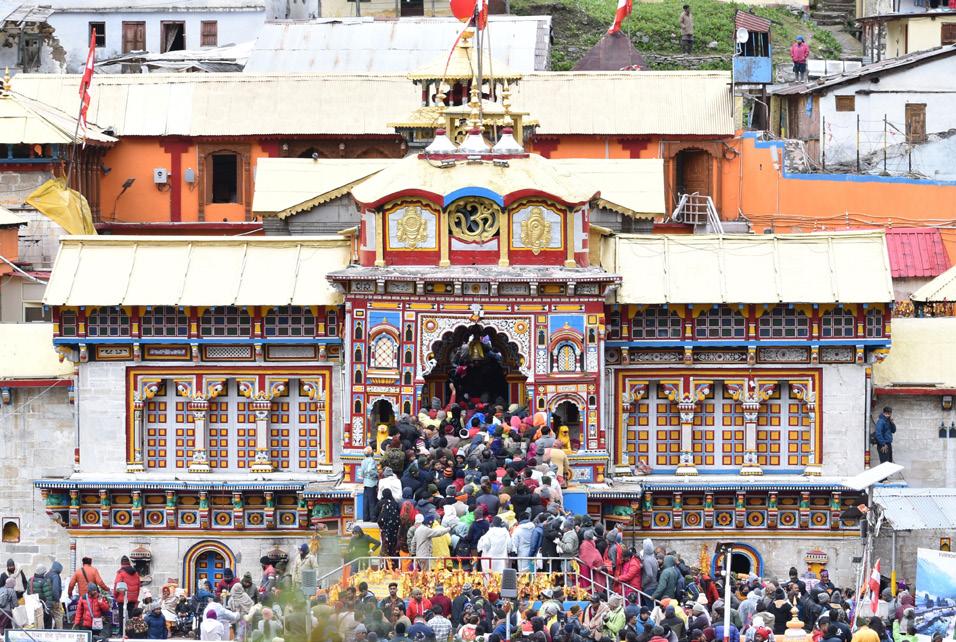
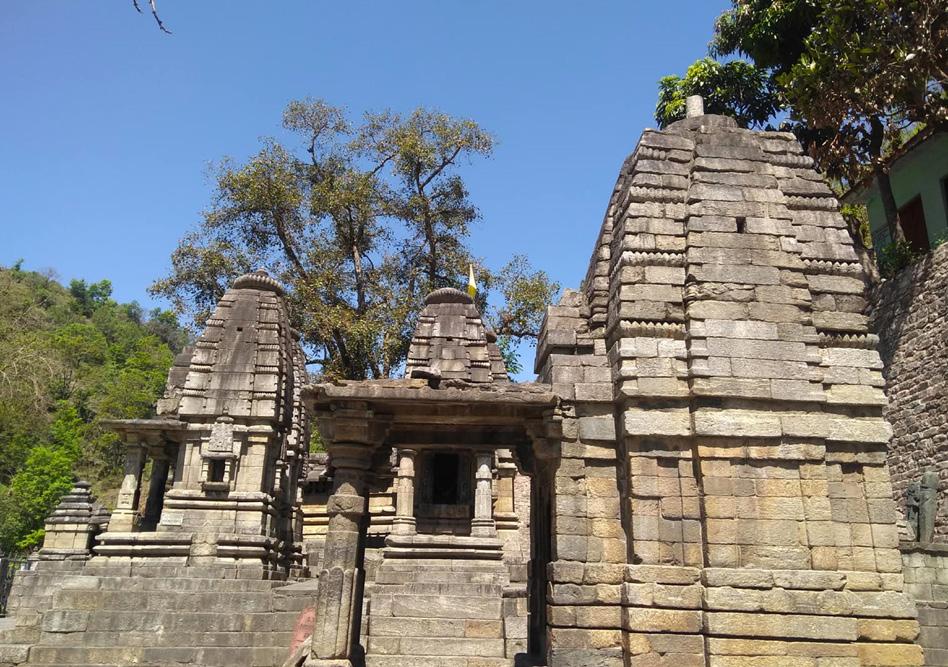 Badrinath, Chamoli
Badrinath, Chamoli
Yogadhyan Badri, also called Yoga Badri, is located at Pandukeshwar near Govind Ghat and is contemporary to the main Badrinath temple. Legend has it that King Pandu, father of the five Pandavas, meditated here with Lord Vishnu to cleanse him of the sin of killing two deer. Kunti married Pandu at Pandukeshwar, and the Pandavas were also born here. Pandu is believed to have installed the bronze image of Vishnu in the Yogadhyan Badri shrine. The idol is in a meditative posture, thus the image is called Yoga-dhyan (mediative) Badri.
Bhavishya Badri is located in a Subhai village near Tapovan, Joshimath. It is located along the Dhauli Ganga River on an ancient pilgrimage route to Mount Kailash and Manasarovar.
According to mythology, when evil transcends the world, the mountains of Nara and Narayana would block the route to Badrinath rendering the sacred shrine inaccessible. Then, Badrinath will appear at the Bhavishya Badri temple and be worshipped here, instead of the Badrinath shrine.
5)Dhyan Badri
Dhyan Badri is located in the Urgam valley, close to Kalpeshwar on the banks of river Kalpa Ganga. The legend of Dhyan Badri is assosiated to the Urva rishi, son of King Puranjaya of the Pandavas lineage who meditated in the Urgam region and established the temple for Vishnu. The image of Vishnu is four-armed, made of black stone, and in a meditative posture. There is a nearby temple dedicated to Lord Shiv built by Adi Shankaracharya.
Vriddha Badri is located in the Animath village in Joshimath. Legend has it that Lord Vishnu appeared as a Vriddha (old man) before sage Narada who performed penance here. The idol installed at this temple is in the form of an old man. It is said that Badrinath was worshipped here by Adi Shankaracharya, before his enshrinement at the Badrinath temple. The temple is open throughout the year.



 Yogdhyan Badri, Pandukeshwar
Bhavishya Badri, Subhai Village
Dhyan Badri, Urgam Valley
Yogdhyan Badri, Pandukeshwar
Bhavishya Badri, Subhai Village
Dhyan Badri, Urgam Valley
Ardha Badri is a secluded settlement situated on the Joshimath-Tapovan road. It is accessible only by trekking through a bridle path. The temple is known as Ardha Badri (literally, half Badri), which refers to how small the idol is.
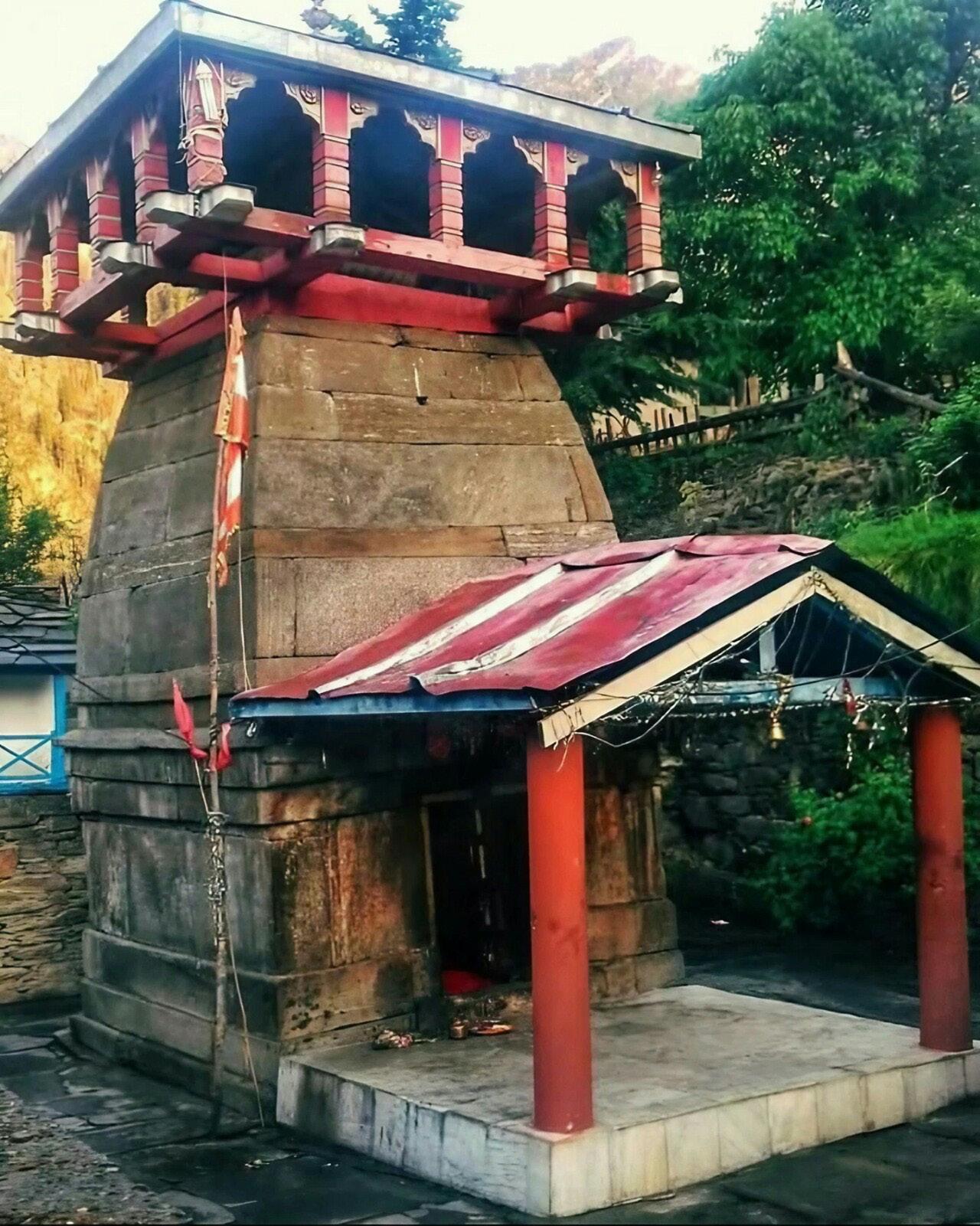
Chapter 02
Among one of the seven badri(s), Adi Badri is worshiped as the first pilgrimage of Badrikashram. When Badrinath’s Kapat (doors) are closed during the winter, Lord Vishnu devotees offer prayers at Adi Badri.
The founding of Adi Badri is attributed to the sage Adi Shankaracharya. Some temples are said to have been built under the Gupta emperors between the 5th and the 8th centuries AD. In ancient times, it was also known as Narayan Math as it was the meditation place of sage Narayan. He was the son of lord Brahma, the author of the Purusha Sukta mentioned in the Dasam Mandal of Rigveda, and the founder of Badrikashram.
Location:
Adi Badri is situated in the mountain range commonly known as the Beni Mountains, at an altitude of 1,630 meters above sea level, adjacent to the erstwhile Parmar capital of Chandpur Garhi. There are two routes to reach Adi Badri, one via Nainital, Ranikhet, Dwarahat, Chaukhutia, and Gairsain. The second one is from Haridwar via Rishikesh, Devprayag, Srinagar, Rudraprayag, and Karnaprayag. The distance between Adi Badri and Haridwar is around 213 km.

A short distance from the temple, the Atagad aka Narayan Ganga, a tributary of the Pindar River, flows downstream from the main road. Flowing from the upper part of Benital, Atagad joins the Pindar River near Simli. 6 Km from Simli, Pindar emerges from the Pindari glacier in Kumaon, enters Garhwal, and joins the Alaknanda River at Karnaprayag to form the Sangam.
In his book ‘Art of the Central Himalayas, Vol-2, archaeologist Dr. Yashwant Singh Katoch mentions that these temples were not constructed in one period but in a phased manner. The construction of Adibadri temples continued during the declining rule of Katyur rulers with some elements from the Pratihar architectural style from central India till the beginning of the tenth century.
In his book ‘Uttarakhand Yatra Darshan’, historian Shivprasad Dabral says, the temples with decorated entrances, and no front verandah belong to the oldest temples of the Gupta period (after the post-Kushan period). The temples without ornamentation but with wide verandahs belong to a later era.

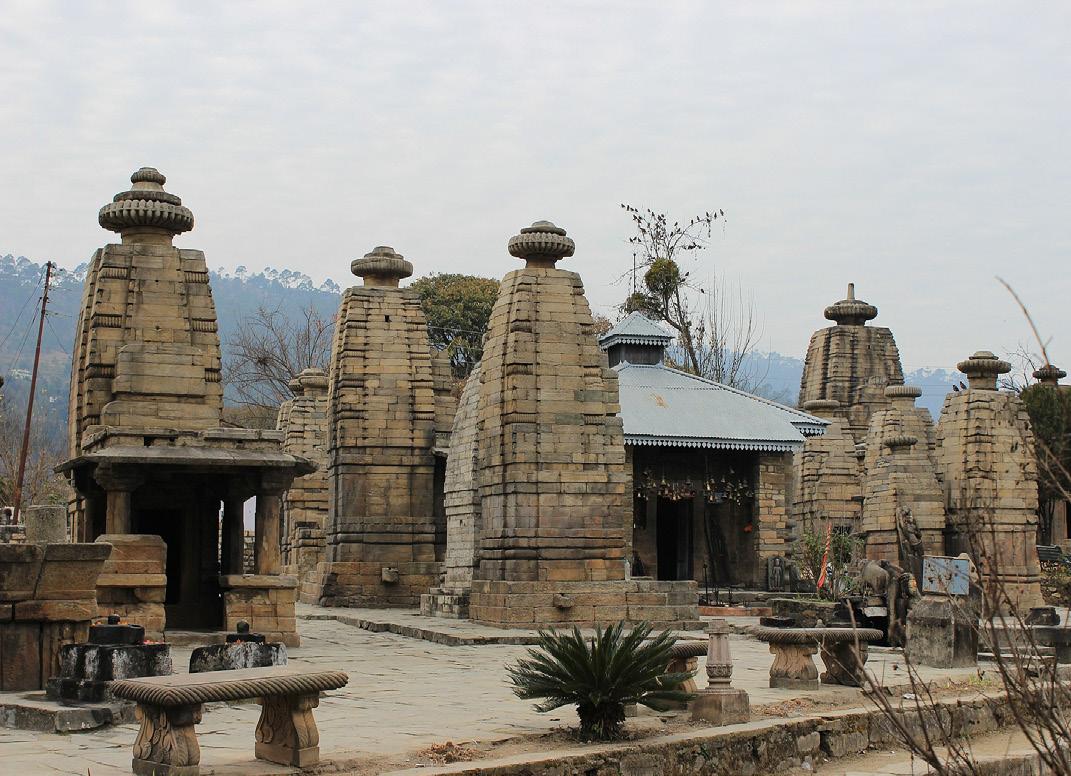
When we look at the other temples constructed during the time of the Katyuri dynasty, we find an uncanny resemblance in the Adi Badri group of temples.
Adibadri is regarded as Lord Vishnu’s original place of meditation. There are similar worship rules to those at Shri Badrinath Temple. Early in the morning, Vishnu’s idol is adorned with a silver umbrella and crown. The idol is decorated with clothes and other ornaments. Every day at 5 am, water anointing is carried out, rice is served at noon, and between 7 and 8 evenings, an aarti is performed. After the aarti at night, all the ornaments of Lord Vishnu are removed and he is ‘rested’.
Every year, the doors of this temple are closed for a month from Sankranti in mid-December and open on January 14, Makar Sankranti. During the opening of the doors, special prayers are offered in the temple, and Vishnu Purana is recited.
Management:
This temple is not under the Shri Badrinath Kedarnath Temple Committee (BKTC). There is a committee of priests of their own who manage the temple. The priests of Adi Badri temple are Thapliyal Brahmin of Thapli village located nearby.
Sun Temple, Katarmal Baijnath Temple ComplexDuring the Gupta and post-Gupta periods, Nagara-style construction also started in the mountainous region of northern India. The Adi Badri temple complex is constructed in Nagara style as some of the basic characteristics in the temples are such as:

• Like the Nagara architectural style, the Vishnu temple has a tall curvilinear spire ‘Sikhara’ with an ‘Amalaka’ (Keystone) on top of the spire.
• In Nagara style, garbhagriha is always under the shikhara.
• The ‘Kalasha’ design coronets the square Sanctum Sanctorum entrance which is through a carved doorway.
• The temples are built on a stone platform with a staircase leading to them. It is a distinct feature of the Nagara style of architecture.
• Another unique feature is the lack of elaborate boundary walls or gates in the Adi Badri complex.
Adi Badri was formerly a group of sixteen temples. Currently, fourteen temples (large and small) are in good condition. Based on the architectural style of these temples, the date of construction is estimated to be from the 8th century to the 12th century. The size of the temple complex is 84’ X 42’. Archaeologists believe that these temples were not built in one period but consequently

• Shree Vishnu Temple
• Durga Temple (Kaali/ Mahishasurmardini)
• Shiva Temple
• Ram-Laxman Temple
• Janaki Temple
• Hanuman Temple
• Gauri Shankar Temple
• Ganesh Temple
• Garuda Temple
• Annapurna Temple
• Lakshmi Narayan Temple
• Satyanarayana Temple
• Kuber Temple
• Sun Temple (Chakrabhan Temple)
Lets discuss these temples in detail:
• Shri Vishnu Temple: It is the largest temple in the precinct. The entrance to the temple is devoid of any ornamentation except the column’s minute ornamentation. In the sanctum sanctorum, there is a fascinating three-foot-tall black stone idol of Lord Vishnu in standing posture, holding a mace, a lotus, and a chakra.
• Durga Temple (Kaali/ Mahishasurmardini): The entrance to the temple is decorated with two lions in the center with a Kaali idol.
• Shiva Temple: The temple is devoid of any ornamentation on the outer façade.
• Ram-Laxman Temple: Navagraha idols are engraved on the both sides of the entrance. There are statues playing drums, manjira, and veena below them. There are also two statues in standing posture on the right and left sides.
• Janaki Temple: There is no ornamentation on Janaki temple.
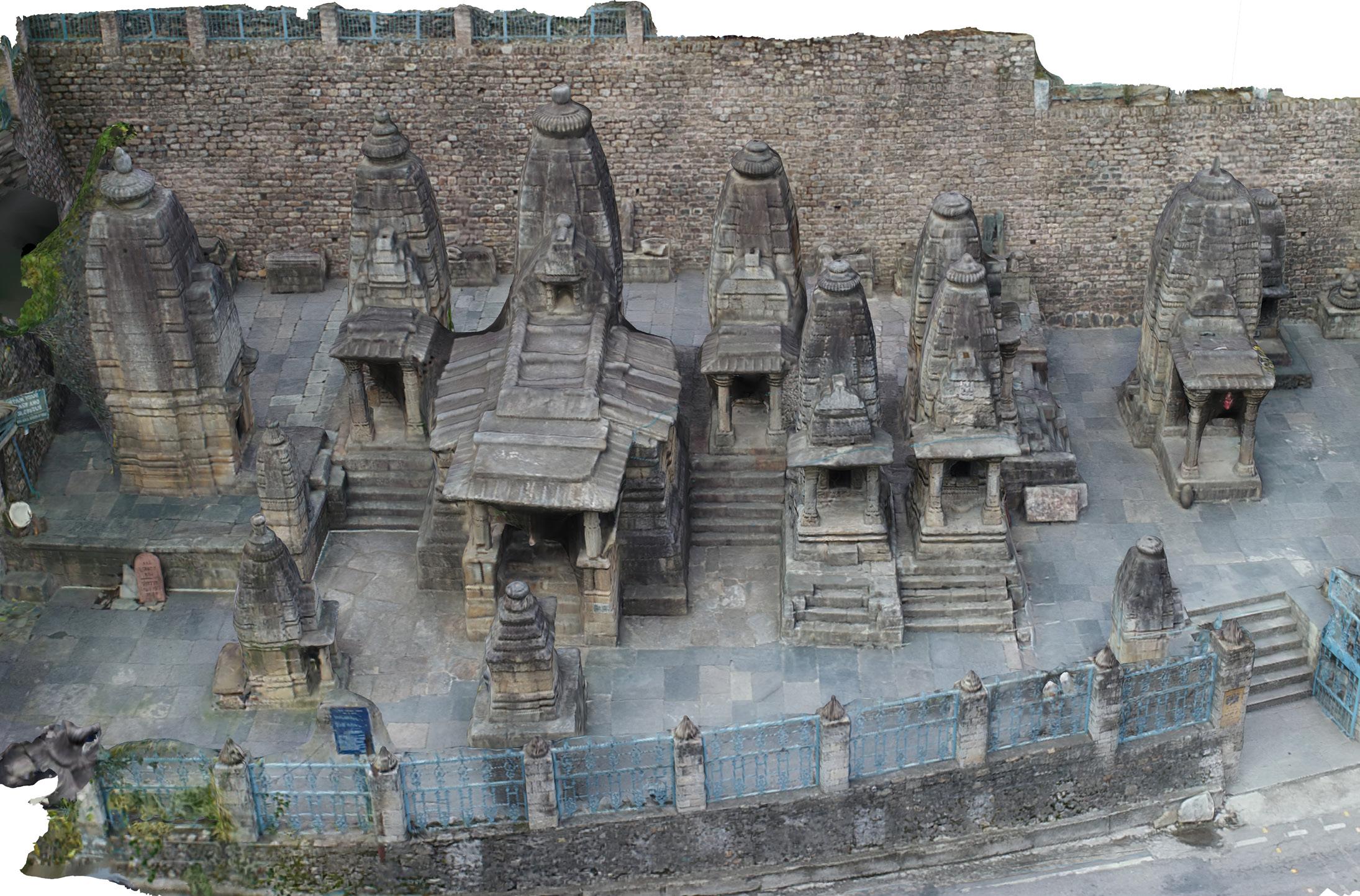
• Hanuman Temple: Navagraha idols on the temple entrance, below them are idols in dancing postures and two God idols on both sides. In the lower part, two idols in meditation shape and two lions with open mouths. The outer pillars are heavily ornamented.
• Gauri Shankar Temple: This temple is slightly inclined. Navagraha idols at the entrance of the temple, two idols standing in dancing postures on the right and left sides are displayed. The Archaeological Survey of India restored this temple for the second time in 2004.
• Ganesh Temple: On the entrance of the temple, the idols of the nine planets are engraved, below these, two idols of gods are displayed in standing posture on the right and left. Minute ornamentation on the pillars.
• Garuda Temple: This temple is devoid of external ornamentation except for the pillars
• Annapurna Temple: This temple is completely devoid of ornamentation.
• Lakshmi Narayan Temple: Lord Ganesha is carved in the middle of the outer door wing of the temple and the bottom row has ornamentation. The rest of the temple is without ornamentation.
• Satyanarayana Temple: Lord Ganesha is carved in the middle of the outer door lintel. The bottom row also has some ornamentation.
• Kuber Temple: The smallest in size, this temple is completely devoid of ornamentation.
• Sun Temple (Chakrabhan Temple): Small in size, this temple is devoid of ornamentation. However, there are some minute carvings on the outer pillars.
On observing the group of Sri Adibadri temples, it is known that Durga Temple, Ram Mana Temple, Hanuman Temple, Gauri Shankar Temple, Ganesh Temple, Lakshmi Narayan Temple, Satyanarayana Temple located in the group are temples with external ornamentation. The main Vishnu temple, the Garuda Temple, and the Sun Temple are sparsely ornamented on the outer pillars. However, Shiva Temple, Janaki Temple, Annapurna Temple, and Kuber Temple are completely devoid of ornamentation.
Seven ancient temples of Adi-badri, seven belong to an earlier period. The rest of the temples seem like later additions to the group.
The main fair held at Adibadri is known as Nautha Kautik. It is held on the first Monday of the hindu month of Jeth in which people from nearby villages participate.
In ancient times, two different groups of two villages used to participate in the temple premises, and there used to be a battle between them with sticks. This battle used to end amidst the playing of drums and instruments. The Narayan Chowk (temple precinct) belonged to the party that won the war. At present, this practice is still maintained, but its form has been changed. Only the party which had won the previous year comes to this temple premises with drums and drums. During this, folk dance and singing is also performed. There is a huge influx of devotees during Janmashtami, Shivratri, and the month of Sawan.
• Vasudhara Waterfall: It is half a kilometer from the temple. People take a bath in this waterfall
• Benital: The beautiful Benital Lake is around 3 km from the Adibadri through lush green forests
• Chandpur Garhi: It is two and a half km from Shri Adibadri towards Karnprayag. The ruins of Chandpur Garhi exist at a distance. It was once the palace of Kanakpal, the Panwar king of Garhwal, which he built around the ninth century. This pargana was named Chandpur after the name of this palace. It was once the most powerful of the major fifty-two strongholds of Garhwal - a fort situated on the border of Garhwal and Kumaon.
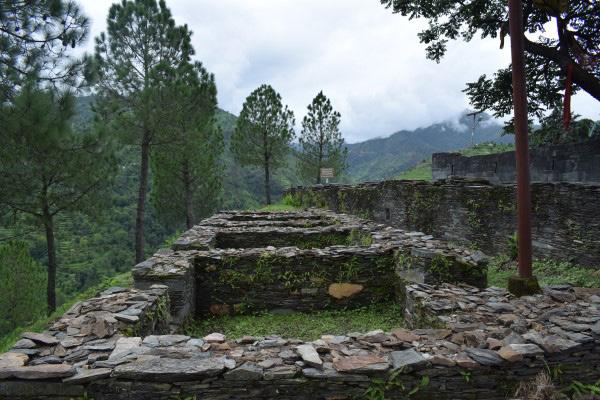
Nanda Devi has been the presiding deity of Garhwal’s subjects, kings, and Katyuri rulers for eternity. Chandpurgarhi has also been one of the stops of the Nanda Devi Yatra. On one side of this fort is the temple of Chamunda Devi, and on the other is the temple of Kuldevi Rajarajeshwari of the Panwar dynasty. There is Shaileshwar Math on the northwest hill, about which there is a legend that at the time of the establishment of the Chandpur fort, the sages living here had said that one day the fort would collapse, and the math would survive.
Chapter 03
Adi Badri complex is located near Karnaprayag in Chamoli district in Uttarakhand. The site elevation is around 1250M from sea level. The area is predominantly residential, and the site is surrounded by residences on three sides and a highway on the fourth.
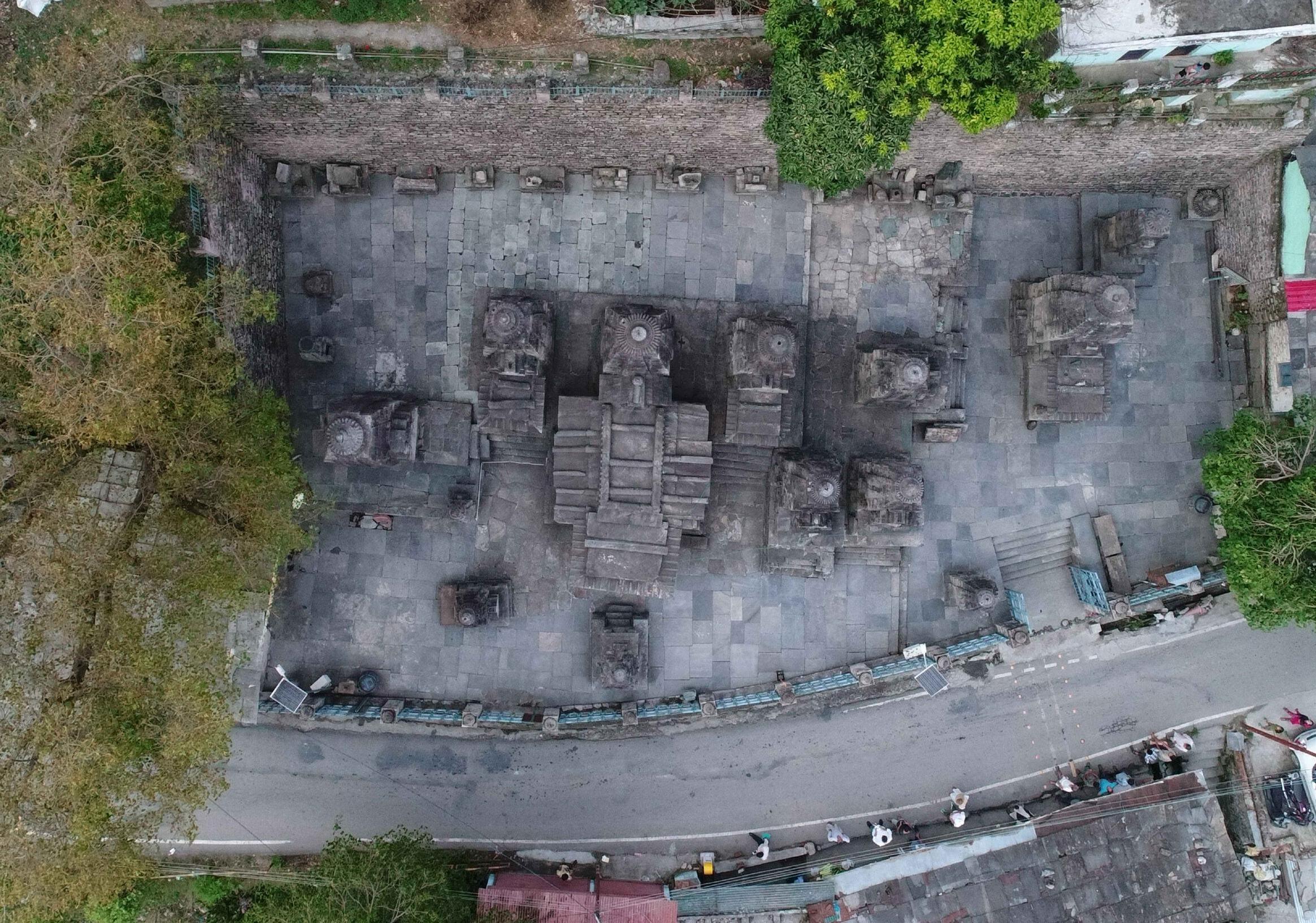
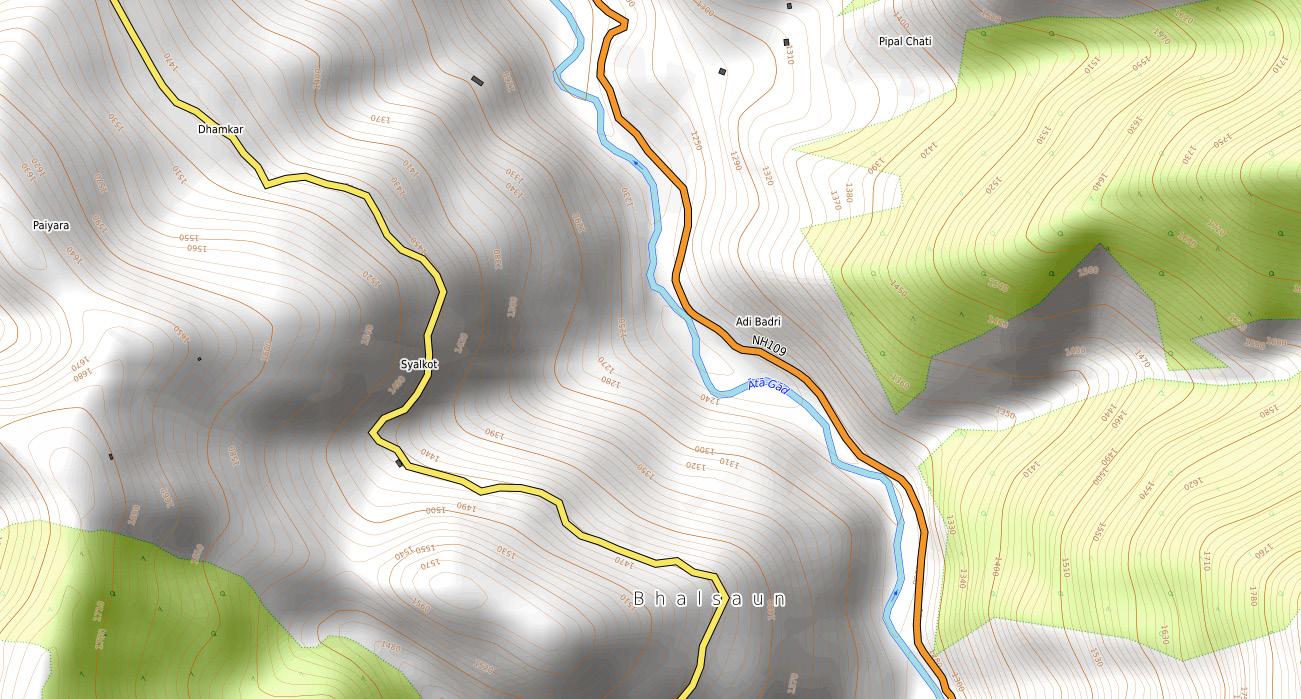 Site Plan, Adi Badri Complex (NTS)
Elevation Map, Adi Badri Complex (NTS)
Site Plan, Adi Badri Complex (NTS)
Elevation Map, Adi Badri Complex (NTS)
0 2M 0.5M 1M
Chapter 04
Ground Floor Plan, Shri Vishnu Temple
Rear Elevation, Shri Vishnu Temple
Chapter 05




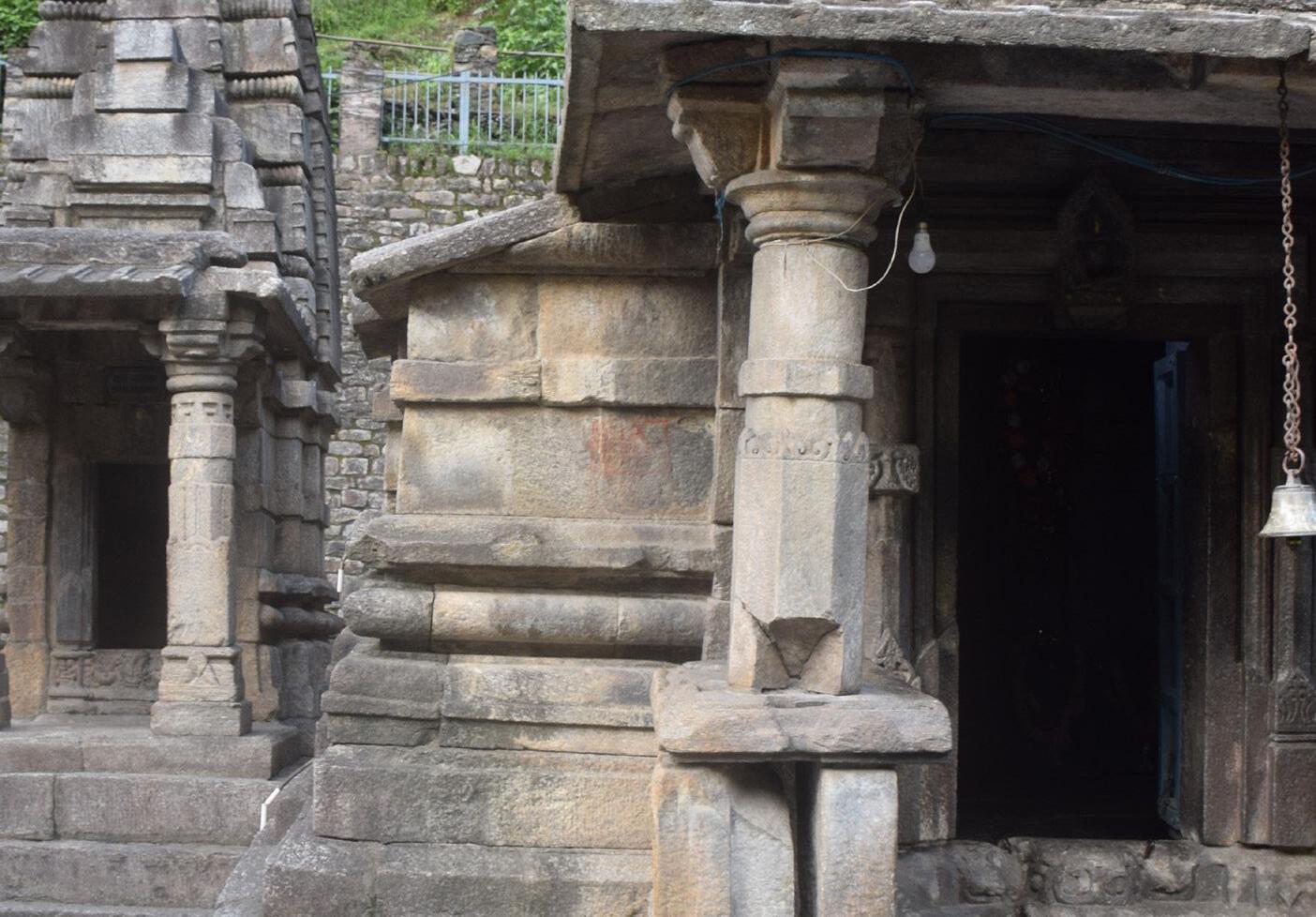
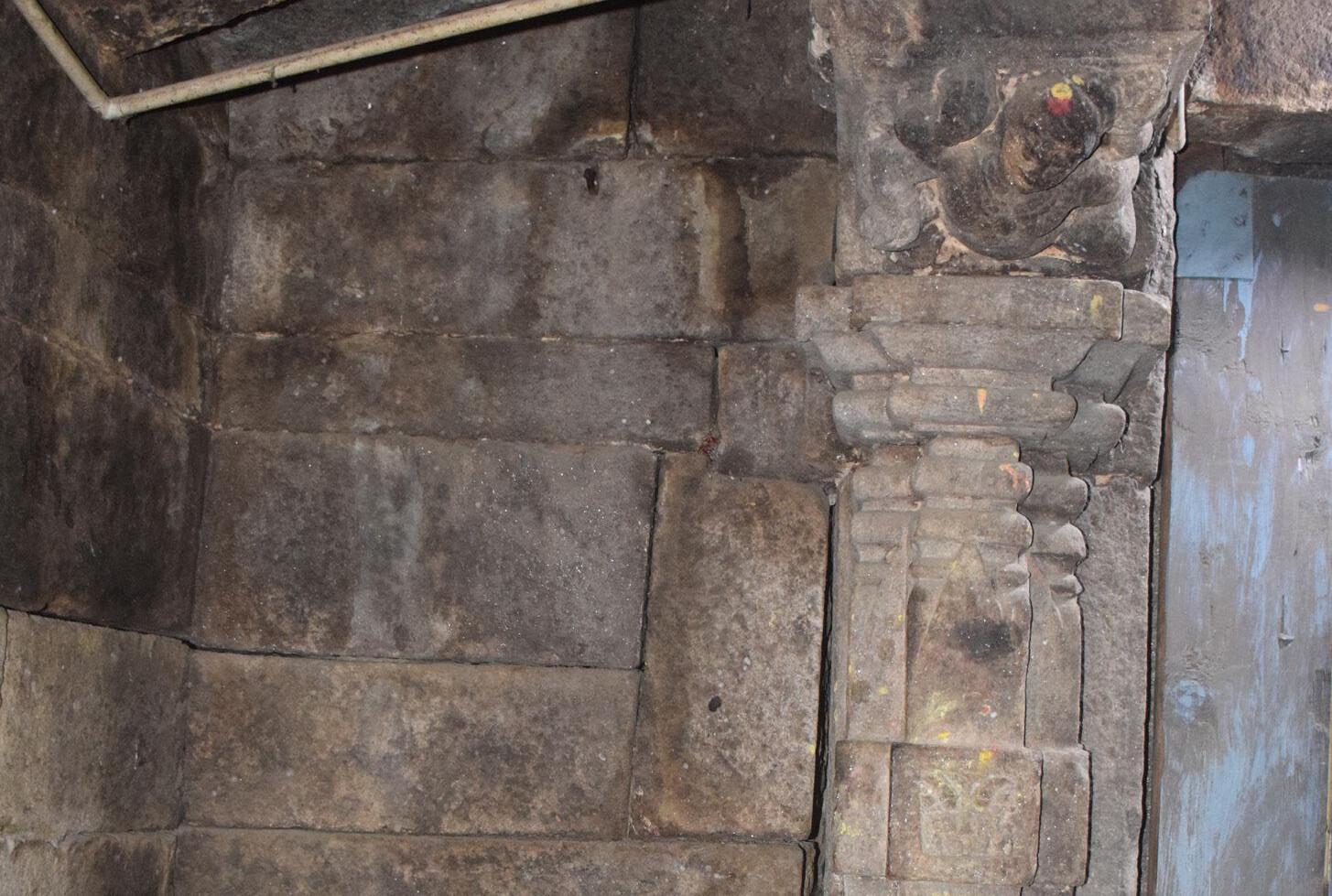 Broken Amalaka
Broken Pillar
Broken Amalaka
Broken Pillar
